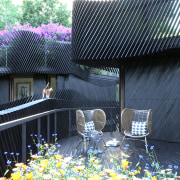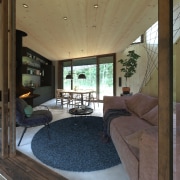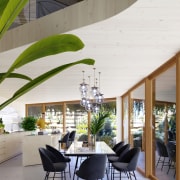Biophilic apartments the way of the future?
What is biophilic architecture exactly? The short answer might be architecture shaped with your ergonomic needs and that of the planet's in mind. Find out what it means in this future-perfect apartment complex
Designed by GG-loop
From the architects: MITOSIS Biophilic Regenerative Ecosystem
The need for healthy homes has hardly ever been more apparent than during the current global condition.
The current efforts to reduce the negative impacts of buildings are inadequate. Therefore the built environment must be designed in a different way.
To bring regenerative collective habitation to all scales of development, Amsterdam architecture practice GG-loop, sharing the vision with British multinational professional services architecture Arup, is developing Mitosis: a modular building system created by a parametric design tool following biophilic and user-centric design principles.
Mission
GG-loop's goal is to develop an architectural solution that "gives back" to the planet and can serve as a benchmark for the real estate and urban development sector. Mitosis’ vision is to deepen the understanding of its relationship with nature, to raise awareness and sensitise both professionals and the general public regarding the importance of biophilic architecture as an answer to the current climate condition.
Sharing the same vision as Arup, GG-loop works to inspire and provide healthy sustainable living communities and net-positive impacts on ecology and society.
By working with the natural environments rather than against it, the natural balance and health of the planet can be restored.
Mitosis aims to support the daily uses and the tasks of the inhabitants, in order to promote direct and indirect contact with nature. We aim to generate a healthy, emotional, and productive habitat for rest, work, and living at 360° with nature.
Inspiration
Mitosis is the follow-up of a multi-awarded pilot project completed by GG-loop in 2019: Freebooter, a pair of prefabricated CLT (Cross Laminated Timber) apartments in Amsterdam, wrapped in a parametric timber louvered facade.
The building was created using biophilic principles, connecting architecture with nature in order to improve the life quality of the people who use the building.
GG-loop’s ambition to bring these qualities to multiple scales has resulted in Mitosis.
The name Mitosis refers to the biological process of a single cell dividing itself into two identical daughter cells.
It represents the modularity and the long-term adaptation of the system and serves as a metaphor for a flexible co-living organism where each residential unit coexists in symbiosis with all the others and its environment.
Bringing biophilic design to large-scale developmentsMitosis adopts principles of biophilic design and articulates the relationships between nature, human biology, and the design of the built environment. It builds an ecosystem where dwellers experience a unique way of living and fulfils their innate desire to reconnect with nature.
Exposed to green shared areas, tiny forests, and gardens that cascade up and down the entire building, dwellers can benefit from the direct and indirect connection with nature.
Health and well-being are fostered through careful material choices, flexible layouts, organic interiors, and large outdoor spaces.
Our vision goes further than the integration of just green systems, but rather creates a built environment that restores and nurtures its surroundings, and that serves as a catalyst for positive change.
Positive footprint ecosystems
Mitosis creates regenerative ecosystems with a positive ecological footprint.
It balances the technical benefits of an environmentally conscious construction with the qualities of an organic and healthy environment in which its residents coexist harmoniously.
Mitosis generates urban clusters using prefabricated timber and bio-based modules that are cost-efficient and flexible in its construction.
By consciously choosing materials that capture carbon and using resources more efficiently, Mitosis constructs a net-positive built environment that produces more energy than it consumes and uses resources in a circular way.
The enhancement of biodiversity in the urban fabric has a beneficial impact on the quality of life and the environmental education of the inhabitants. Mitosis integrates plant and animal life throughout the buildings, allowing its dwellers to coexist harmoniously with the biodiversity of local flora and fauna.
Mitosis is designed to co-evolve with its surrounding, by recreating ecosystems appropriate to the climate, site, and residents. In this way, Mitosis can facilitate the conservation and improvement of the biodiversity that exists on the site.
We are part of nature in a deep and fundamental way, but in our modern lives we’ve lost that connection. In addition to the technical benefits of acoustics improvement, CO2, and urban heat reduction, being in direct contact with nature has proven to improve physical and mental health and overall well-being.
Social cohesion
The distinct rhomboid shape of the individual design modules is integral to the functionality of Mitosis. Stacking these modules creates large areas for shared outdoor living, with each unit having at least one terrace.
Mitosis’ vertical connections are placed externally to connect the units and terraces, creating a continuous ribbon of outdoor ‘cloister-like’ spaces, fostering a sense of openness, belonging, protection, and privacy for residents.
Mitosis’ construction is organic and flexible, providing large areas of urban and vertical farming, greenhouses, wildlife corridors, and integration of habitat creation, that encourage shared outdoor activities among residents.
By applying elements of nature and providing available renewable resources in shared facilities and infrastructures of community living, Mitosis encourages dwellers to engage in pro-environmental practices and share their expectations of sustainability. This helps create healthier environments and improve social interaction.
Project development
Mitosis is developed by parametric and BIM 3D modeling software. It generates dwelling clusters composed of prefabricated CLT modules through a complex iterative process.
The optimised volume and scale of Mitosis are based on the calculation and simulation of parameters related to specific stakeholders' needs and conditions of a given site.
The volumes and internal layouts derive from the calculation and simulation of parameters related to specific conditions of the site: solar radiation, wind impact, privacy, population density, common spaces index, and vertical connections.
With the parametric design tool, Mitosis explores how buildings can grow, evolve, heal and self-sustain, similar to human bodies, as well as use biological metaphors to design buildings capable of regeneration, resilience, and self-sufficiency.
Due to its flexible structure and grid formation, Mitosis is able to host a variety of typologies that are customisable to the resident’s needs.
It is applicable to diverse urban scales, ranging from off-grid single-family detached houses (30m2 up to a quadruplex 120m2 ) to high-density mixed-use urban clusters that incorporate public functions such as education, leisure, wellness, and retail.
Mitosis generates experiential spaces that respect both the environment and its direct inhabitants, reconnecting both in a balanced ecosystem.
By accommodating for all sizes, typologies, and performance levels, Mitosis moves beyond the basic concept of sustainable design and shifts towards a design that focuses on producing net-positive impacts on the environment.
Credit list
Architects
Design team
Home kitchen bathroom commercial design
Reflection and repose
9 tile shapes and finishes that think outside the square
White cloud, blue sky
Commercial Design Trends Vol. 35/1C
A new commercial office building can sometimes be more than just a place to work – it can also be an integral component ...
Read More



















